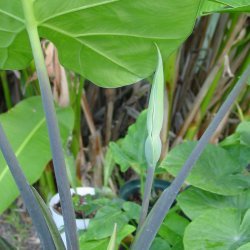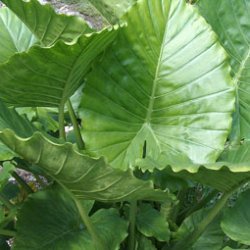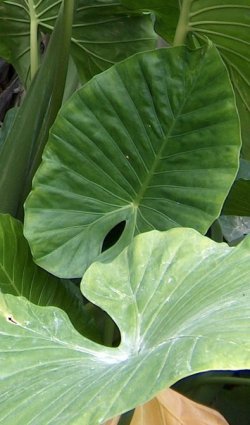





The archetypal Alocasia odora is among the hardiest of the Big Ears. Of course, when discussing tropical greenery, "hardy" is a relative term. Here I mean that a frost or light freeze will not kill the plant, and that this species can survive in subtropical climates without extraordinary protection. It is in working with this group, though, that I've learned that the lines between species can be blurrier than one might imagine. . .
Of all the Big Ears in cultivation, this one is the Ear to choose if you are concerned about whether the plant can grow well in your garden. A. odora is so durable, at least in my experience, that I chose it as the foundation of my Alocasia breeding work. Years after I began hybridizing, though, I discovered that more than one type of A. odora can be found. The thumbnail picture at right is an example of what I call the "Indian Odora", a plant that looks like a larger and more robust version of A. cucullata. In fact, a well-grown young A. cucullata is nearly indistinguishable from a young plant of the Indian Odora. The difference becomes evident, however, when you see that the Indian Odora just keeps on growing larger while A. cucullata matures at a much smaller size.
Soon I found another variety of A. odora, the one I refer to as the Blue Odora, or A. odora 'Azurea'.  This plant is so named because of the bluish or purplish coloration on the petioles and peduncles (see picture, below left). This coloration is more pronounced when the plant is grown in shade; too much sun will tend to wash it out. Some are now marketing this particular odora type as "Alocasia gigantea", a nonexistent species! The plant hails from the Yunnan province of China, and is used in local herbal medicine there. In regards to cool-hardiness, I've had specimens whose leaves were scarcely damaged by temperatures in the low 30s and frost. Of course, my regular A. odora has shown similar hardiness so I am convinced that it runs in the family, as it were.
This plant is so named because of the bluish or purplish coloration on the petioles and peduncles (see picture, below left). This coloration is more pronounced when the plant is grown in shade; too much sun will tend to wash it out. Some are now marketing this particular odora type as "Alocasia gigantea", a nonexistent species! The plant hails from the Yunnan province of China, and is used in local herbal medicine there. In regards to cool-hardiness, I've had specimens whose leaves were scarcely damaged by temperatures in the low 30s and frost. Of course, my regular A. odora has shown similar hardiness so I am convinced that it runs in the family, as it were.
In my early work with these plants, I chose a plant known locally in the trade as Alocasia 'California', but which I later learned was Alocasia gageana (see picture, below right).  The overall look of this plant is that of a dwarf A. odora with attractive, rounded leaves and a heavily pupping habit. The inflorescences on it look very much like small versions of the ones on my large A. odora. The cross worked abundantly, and through no effort of my own, one of the seedling segregates got out into the market and is now being sold as the Calidora, but which more accurately is Alocasia x calidora.
The overall look of this plant is that of a dwarf A. odora with attractive, rounded leaves and a heavily pupping habit. The inflorescences on it look very much like small versions of the ones on my large A. odora. The cross worked abundantly, and through no effort of my own, one of the seedling segregates got out into the market and is now being sold as the Calidora, but which more accurately is Alocasia x calidora.
Curiously, some of the seedlings of this cross came out looking like miniature versions of A. cucullata! This observation, and others, started me wondering if A. gageana and A. cucullata were actually cultivars or sports of A. odora, rather than actual species in their own right. Whether they are or not is a project for research, but as far as gardening goes, all of them are easy growers and generally cool-hardy. They respond well to plenty of water, a fertile well-draining soil with ample organic matter, and fertilization at least once per month during the growing season, or more frequently if you are prone to push your plants. However, if you are wanting Big Ears, you'll want to choose the big green "original" A. odora or the A. odora 'Azurea' for your garden.

While working with A. gageana, I noted that the plant sets seed fairly easily. Germinating these seeds yielded some plants that looked like the parent, while others looked and grew surprisingly like the standard large green A. odora (picture at left). Curiouser and curiouser! I found a similar result when germinating seeds from the Indian Odora; some looked like the parent, but others looked like intermediates between the Indian Odora and the regular Odora. I now suspect that someone, perhaps many years ago, was tinkering around with A. odora and may have originated what we know now as A. gageana and A. cucullata.
In the course of my work, I found an F2 seedling segregate (from selfing the A. x calidora) that looks a lot more like a type of A. macrorrhizos than A. odora. The inflorescence and the known parentage are the characteristics that keep it allied to A. odora. I've named this plant the "Green Giant" because it looked to me like it was going to grow much larger than A. odora. So far, it has not yet delivered on this, but could still surprise me in the near future. As an interesting and related aside, I have observed that a plant known as Alocasia wentii, having leaves with purplish-brown reverses, also has inflorescences that look strikingly like those on A. odora, and smell like them too, but the blooms are sexually sterile! Thus I have reason to feel that the history of this group of plants is more varied, malleable and perhaps human-influenced than a simple list of species would have one believe.
Photo credit: LariAnn Garner, Aroidia Research
Copyright © www.100flowers.win Botanic Garden All Rights Reserved